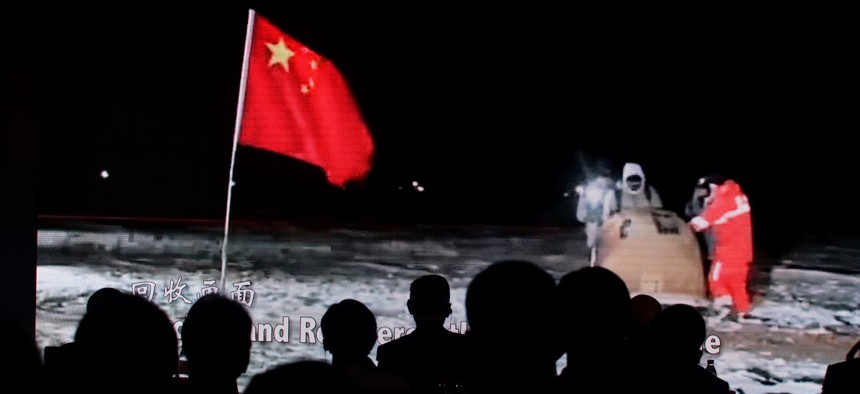
Audience members take photos of a screen showing a video about China's Chang'e-5 moon probe in Beijing on January 18, 2021. GREG BAKER/AFP via Getty Images
DIA Warns China’s Space Tech Seeks to Block U.S. Radars, Jam Munitions
Beijing’s rapid acquisition of counter-space capabilities is most worrisome, says a new 80-page Defense Intelligence Agency report.
China has become increasingly reliant on space to prevail in a major conflict with the United States and is aggressively launching, acquiring, and obtaining through espionage the counter-space capabilities necessary to do so, according to a new Defense Intelligence Agency space security report released Tuesday.
In the 80-page report, DIA updates the gains in satellite operations and human spaceflight that China and Russia, and to a lesser extent North Korea and Iran, have made over the past year.
“As China’s and Russia’s space and counterspace capabilities increase, both nations are integrating space scenarios into their military exercises,” the DIA found.
But the report makes clear that China’s activities are most worrisome to the United States, not only because of the country’s rapid growth in space—doubling the number of ISR satellites it has in space to 250 since 2018—but also its rapid acquisition and pursuit of counter-space capabilities.
The PLA is rapidly modernizing through both “overt and covert” acquisition of foreign space and counter-space technologies, the DIA found. “China uses traditional technical espionage and cyber espionage techniques as well as its open-source collection network, technology transfer organizations, and exploitation of overseas scholars.”
“The PLA probably sees counterspace operations as a means to deter and counter a U.S. intervention during a regional military conflict,” the DIA wrote. “China has claimed that ‘destroying or capturing satellites and other sensors’ would make it difficult for the U.S. and allied militaries to use precision-guided weapons.”
The DIA also found that China “probably is developing jammers dedicated to targeting SAR, including aboard military reconnaissance platforms,” referring to the advanced synthetic aperture radar systems that allow clear imagery even at night or during bad weather.
Those jammers would be key to preventing the U.S. and U.S.-affiliated commercial satellite firms from maintaining a clear picture over Taiwan, as they have in Ukraine.
“Interfering with SAR satellites very likely protects terrestrial assets by denying imagery and targeting in any potential conflict involving the United States or its allies,” the DIA said. It noted China’s jammer advancements also likely include the capability to interfere with satellite communications “over a range of frequency bands, including military-protected extremely high frequency communications.”
In the seven weeks since the war began, while Russia has conducted counter-space operations against Ukraine—including jamming—it has also had its own lines of communication severed, leaving Russian ground units without direction or logistical support.
Many of its precision-guided munitions have failed, forcing Russian aircraft to rely on dumb bombs. By late March, when Russia was launching 300 sorties a day, at least 20 percent—and possibly as many as 60 percent—of its air-launched missiles were malfunctioning, forcing aircraft to return to base with the munitions still attached to their wings, a senior defense official told reporters.
Ukraine has been able to persist and resist in part because of commercial satellite firms that provided Ukraine the ability to push back on Russia’s electronic warfare and disinformation campaigns. That’s something China is watching closely, and will likely not be as big of an advantage in a fight for Taiwan, satellite experts at last week’s Space Symposium cautioned.
“The Chinese are leaning back and taking notes,” said HawkEye 360 board member Lynn Wright, a former deputy director of naval intelligence and director of Naval Intelligence Activity. Commercial satellite firm Hawkeye 360 has helped isolate the location of Russian jammers by providing continuous monitoring of reports of interference. China has also watched Russia lose the information war, Wright said, and “you should expect that the Chinese will do a much better job. They will have a faster cycle rate.”
That means the U.S. has to quickly adjust, too, said Todd Harrison, director of the aerospace security project at the Center for Strategic and International Studies.
The proliferation of satellites “is changing the way that we fight and the way that the world is able to see the fight, to be able to see what's happening on the battlefield. It changes that deterrence calculus,” Harrison said. “It changes the way countries like China might be thinking about Taiwan. And I think we've got to start adjusting.”
In a potential conflict over Taiwan, or in the South China Sea, there will not be the advantage of both U.S. military and commercial satellite firms agreeing to protect and not reveal information to the public on Ukrainian military operations, Wright said.
Instead, the U.S. and partner forces would likely be publicly tracked through satellite-enabled social media supporting China, Wright warned.
In a potential China fight, there would be “a lot less people on our side, on the West, on the side of democracies in a China fight,” Wright said. “And capabilities are going to continue to improve. And so some of our aviation forces are going to be at risk.”




